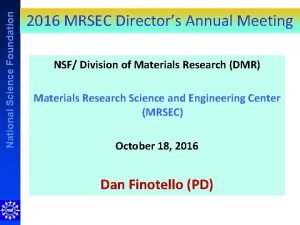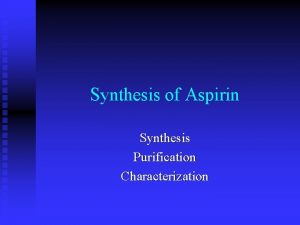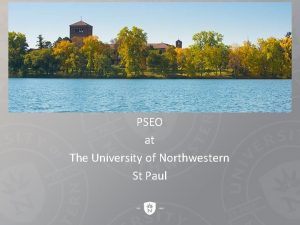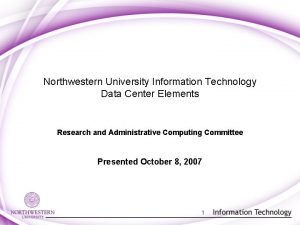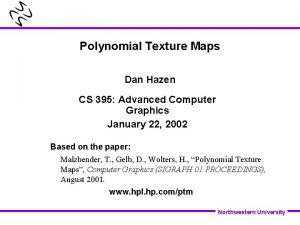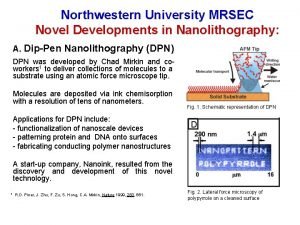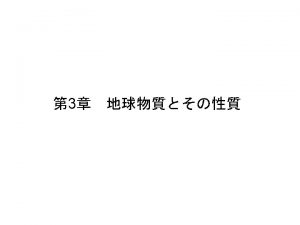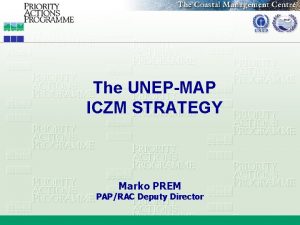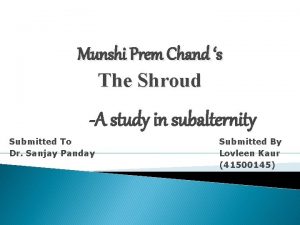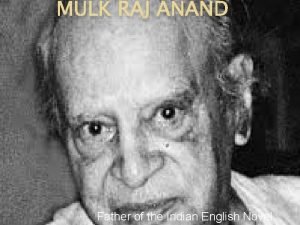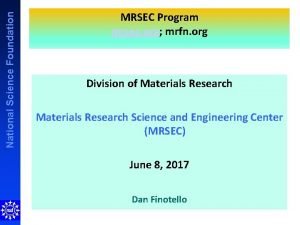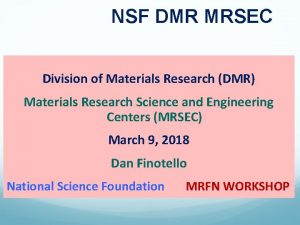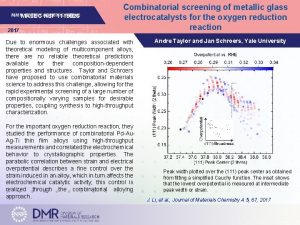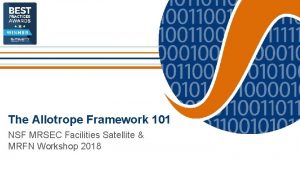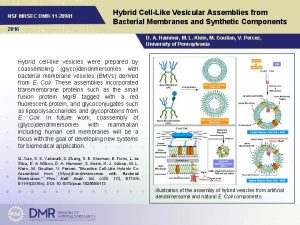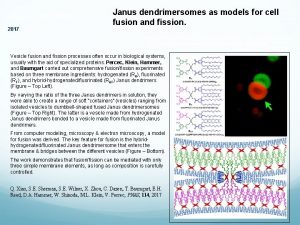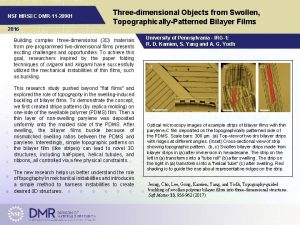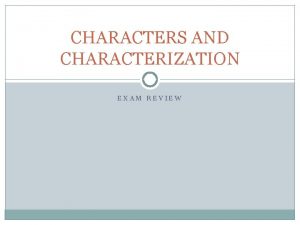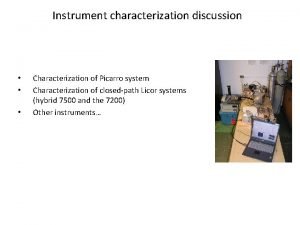NORTHWESTERN UNIVERSITY NSF PREM MRSEC Synthesis and Characterization

















- Slides: 17

NORTHWESTERN UNIVERSITY NSF - PREM - MRSEC Synthesis and Characterization of Rare Earth Nanomaterials and their Biological and Photonic Applications Dhiraj Sardar Department of Physics University of Texas at San Antonio March 10 and 11, 2011

Outline • • Introduction to Rare Earths Methods Important Facilities Results – Theoretical and Experimental Potential Applications UTSA Physics Department -PREM Students PREM Publications and Acknowledgements

Introduction to Rare Earths Electron charge distribution in different orbitals for RE ions showing the shielding of 4 f electrons by outer 5 s and 5 p electrons Electronic Configuration (RE 3+) : Incomplete inner 4 f. N orbital : [Xe]4 f N 5 s 25 p 6(N=1 13) Energy levels of trivalent rare earths (RE 3+ ) Optical Properties : Strong absorption and fluorescence : Wide range of excitation and emission (UV-VIS-IR) Applications : Lasers, Display, Sensor, Therapy, Biomedical imaging, etc.

Methods 1. Synthesis • Solvothermal/Hydrothermal • Precipitation • Thermolysis 2. Morphology Characterization • XRD, EDX • SEM, TEM, STEM • AFM 3. Optical Characterization • Refractive Index • Optical Absorption/Reflection/Scattering • Steady State Emission • Fluorescence Lifetime • Optical Gain • Efficiency(Internal, External, Conversion, Slope) • FTIR/Raman

Important Facilities Ø Laser Research Laboratory v Lasers: Argon, Nd: YAG, Ti: Sapphire, Diode (Vis-IR) v Cary-14 Spectrophotometer v SPEX 1250 M Monochromator v Cryogenic Cryostat Ø Microscopy Laboratory v STEM w/EDX v HR-TEM w/EDX v AFM v Raman Ø XRD JEOL-ARM 200 F(0. 06 nm resolution)

RESULTS STEM imaging of the Nd 3+ distribution Nd 3+: Sc 2 O 3 Blue = Scandium , Red = Oxygen

Theoretical (Judd-Ofelt Formalism) Radiative Process: (Judd-Ofelt Model) Major Nonradiative Processes: 4 F 7/2 AET 1. Multiphonon relaxation (Amp) 2. Energy transfer between ions (AET) 3. Hydroxyl content/High frequency vibrational groups (AOH) 4. Impurity (Aimp) 4 S 3/2 4 F 9/2 4 I 11/2 4 I 13/2 Amp 980 nm Pump 1550 nm AOH 550 nm 650 nm AET 4 I Er 3+ Radiative Quantum Efficiency: Arad=radiative decay rate Anr=nonradiative decay rate 15/2

Nd 3+: Y 2 O 3 Absorptions from Ceramic and Embedded in Polymers Nd 3+: Y 2 O 3 Ceramic Nd 3+: Y 2 O 3 in Epoxy Nd 3+: Y 2 O 3 in HEMA Polymer embedded samples yield similar spectral features to polycrystalline ceramic sample

RE 3+: Y 2 O 3 Emissions from Nanoparticles Eu 3+: Y 2 O 3 Nd 3+: Y 2 O 3 Epoxy embedded

Comparative Results of Nd 3+ in polymer, ceramic, and single crystals Parameter HEMAa Epoxyb Ceramicc Ceramicd Crystale Crystalf 2(10 -20 cm 2) 6. 75 10. 97 10. 52 4. 09 8. 55 4. 08 4(10 -20 cm 2) 8. 47 5. 68 5. 06 2. 97 5. 25 5. 53 6(10 -20 cm 2) 3. 65 5. 37 5. 28 3. 85 2. 85 3. 97 rad 0. 623 0. 549 0. 532 0. 354 0. 655 0. 589 0. 584 0. 499 0. 504 0. 318 - - 93. 7 90. 9 94. 7 89. 0 - - fl (ms) *Q(%) *Internal radiative quantum efficiency a, b, c Sardar et al. , Polymer Internationa (2005), J. Appl Phys. (2004, 2005) d Kumar et al. , IEEE J Quant. Elect. (2006) E Kaminskii, Laser Crystals, (1996) f Morrison et al. , J. Chem. Phys (1983)

Other RE-Doped Materials and their Potential Applications Transparent Nd: YAG Ceramic Yb. Er Eu Yb. Er Tb Nd: YAG Single Crystal Yb. T m Yb, Er : Phosphate Glass Inset: Pr : Phosphate Glass Eu: Y 2 O 3 : HEMA Polymer Sr. S: Eu. Dy Eu 2+ Host: La 2 O 2 S Top: 980 nm Ex (10 m. W) Bottom: 320 nm Ex: Up Eu: Y 2 O 3 nanoparticles (Homogeneous precipitation) and Down Conversion (Imaging, Display, Therapy, Sensing, Security, Lighting, etc. )

What is so Unique about RE (Nd 3+) for Biomedical Applications? Ø Large Stoke’s shift (~500 nm) & strong emission Ø Multi-frequency absorption & emission Ø Long fluorescence lifetimes Ø Optical properties “independent” of size Ø Nontoxic absorption emission

Imaging Application of RE Nanoparticles Present technology: Organic Dyes and Quantum Dots Advantages-Highly Fluorescent Disadvantages-UV excitation causes autofluorescence, reducing S/N ratio -Size tunability is needed for quantum dots for proper excitation -Toxicity of the composition, Photobleaching Color tunable Q dots a Confocal image of the 980 nm excited Emissions (550 and 670 nm) from Yb, Er: Ca. F 2 Nanoparticles Autofluorescence b (a) Live cell (mouse fibroblast) image with green upconversion under 980 nm Exc. (b) Cell autofluorescence under UV Exc. After background subtraction Future technology: Rare Earth-doped Nanoparticles Advantages-Highly Fluorescent, wide range of excitation and emission (UV-IR), no autofluorescence, nontoxic, no size requirement, no photobleaching

Photodynamic Therapy with IR Upconversion (IPDT) Advantages: IR Upcoversion, 5 times penetration depth compared to Current UV-X PDT

UTSA Physics Department- PREM • • Advanced Engineering and Technology (AET) Building ($82. 5 M; December 2009) – Physics Department occupies the 3 rd floor (over 14, 000 sq. ft. of lab space) – $11. 2 M spent by UTSA to Renovate Physics Research Laboratories Thin Films Laboratory (AET) – ALD, Laser Deposition Biophotonics Research and Imaging Laboratory (AET) Synthesis Labs (AET) – Nanomaterials – Nanophotonics and Laser Materials Terahertz Laboratory (AET) Computational Physics Laboratories (AET) – Access to the Texas Advanced Computing Center (TACC at UT Austin) Advanced Microscopy Laboratory (Science Building) – TEM-STEM, SEM, AFM, Raman – Including the most advanced spherical aberration corrected STEM (JEOL ARM 200 F) Tenure-track faculty Total: 13; PREM: 7 6 Minority; 3 Women 2 Hispanic Women 1 African American Woman

UTSA PREM Researchers • • • • • Dr. Jianhui Yang (2010) Dr. Ajith Kumar (2011) Erik Enrique Joseph Barrios Edward Khachatryan Robert C. Dennis Brian Yust Leland Page Kenneth Ramsey Madhab Pokrhel Nathan Ray Francisco Pedraza Devraj Sandhu Jesse Salas Hector Barron-Escobar Marcus Najera Gilberto Cassilas Garcia Zurab Kereselidze

PREM Publications (2010 -11) Published or in Press: • • • • Chandra, S. *, Francis Leonard Deepak, J. B. Gruber, and D. K. Sardar, “Synthesis, Morphology, and Optical Characterization of Er 3+: Y 2 O 3”, J. Chem. Physics C, 114, 874 -880 (2010). Burdick, G. W. , J. B. Gruber, K. L. Nash, and D. K. Sardar, “Analyses of 4 f 11 Energy Levels and Transition Intensities Between Stark Levels of Er 3+ in Y 3 Al 5 O 12”, Spectroscopy Letters: 43, 406 -422 (2010). Gruber, J. B. , G. W. Burdick, S. Chandra*, and D. K. Sardar, “Analyses of the Ultraviolet Spectra of Er 3+ in Er 2 O 3 and Er 3+ in Y 2 O 3”, J. Appl. Phys. , 108, 023109: 1 -7 (2010). Chandra, S. *, J. B. Gruber, G. W. Burdick, and D. K. Sardar, “Material Fabrication and Crystal-Field Analysis of the Energy Levels in Er 3+ doped Er 2 O 3 and Y 2 O 3 Nanoparticles Suspended in Polymethyl Methacrylate”, J. Appl. Pol. Sci. (in Press) (2011). Yang, J. and D. K. Sardar, “One-Pot Synthesis of Coral-Shaped Gold Nanostructures for Surface-Enhanced Raman Scattering”, J. Nano Res. (in Press) (2011). Yang, J. , R. C. Dennis*, and D. K. Sardar, “Room-Temperature Synthesis of Flowerlike Ag Nanostructures Consisting of Single Ag Nanoplates”, Mater. Res. Bull. (in Press) (2010). B. Yust*, D. K. Sardar, and A. T. Tsin, "Phase conjugating nanomirrors: utilizing optical phase conjugation for imaging", SPIE Proceedings, Vol. 7908 (In Press) (2011). Francis Leonard Deepak, Rodrigo Esparza, Belsay Borges, X. Lopez-Lozano, Miguel Jose Yacaman, Rippled and Helical Mo. S 2 Nanowire catalysts – An aberration corrected STEM study. Catalysis Letters, In Press, 2011. Page, L*, Maswadi, S, Glickman, RD, “Optoacoustic Spectroscopic Imaging of Radiolucent Foreign Bodies”, in Medical Imaging 2010: Ultrasonic Imaging, Tomography, and Therapy, D'hooge, J; Mc. Aleavey, SA, Eds. , Proc. SPIE, Vol. 7629, pp 7629 OE-1 – 7629 OE-7, 2010. Maswadi*, S, Glickman, RD, Elliott, WR, Barsalou N, . “Nano-Lisa for In Vitro Diagnostic Applications”, in Photons Plus Ultrasound: Imaging and Sensing 2011, Oraevsky AA, Wang LV, Eds, Proc. SPIE, Vol. 7899, in Press, 2011. Page, L*, Maswadi, S, Glickman, RD, “Identification of Radiolucent Foreign Bodies in Tissue Using Optoacoustic Spectroscopic Imaging”, in Photons Plus Ultrasound: Imaging and Sensing 2011, Oraevsky AA, Wang LV, Eds. , Proc. SPIE, Vol. 7899, in Press, 2011. Francis Leonard Deepak, G. Casillas-Garcia*, H. Barron*, R. Esparza and M. Jose-Yacaman, New Insights into the structure of Pd-Au nanoparticles as revealed by aberration-corrected STEM”, in Press, 2011 V. H. Romero, W. Egido, Z. Kereselidze*, C. M. Valdez, . E. Michaelides, X. G. Peralta, M. Jose-Yacaman, F. Santamaria. Neurons preferentially internalize goldnanostars with strong and precise photothermal properties. Submitted to Nanomedicine NBM, 2011. X. G. Peralta, “Plasmon modes for terahertz detection: Terahertz Plasmon modes in grating coupled double quantum well field effect transistors”, released by LAP Lambert Academic Publishing (2010 -08 -30) - ISBN-13 : 978 -3 -8383 -9371 -1 (2010). Wilmink, G. J. , Rivest, B. D. , Roth, C. C. , Ibey, B. L. , Payne, J. A. , Cundin, L. X. , Grundt, J. E. , Peralta, X. , Mixon, D. G. and Roach, W. P. , “In vitro investigation of the biological effects associated with human dermal fibroblasts exposed to 2. 52 THz radiation”. Lasers in Surgery and Medicine, n/a. doi: 10. 1002/lsm. 20960, 2011. J. Antunez-Garcia, S. Mejia-Rosales, E. Perez-Tijerina, J. M. Montejano-Carrizales and M. Jose –Yacaman. “Coallescence and collision of gold nanoparticles”. Materials, 4: 368 -379, doi: 10. 3390/ma 4020368, 2011. 16 Published, 4 other papers submitted, and 11 more under preparation All Publications Acknowledge NSF-PREM Support: Grant No. DMR-0934218
 Mrsec science slam
Mrsec science slam Synthesis and characterization of aspirin
Synthesis and characterization of aspirin Northwestern university mn pseo
Northwestern university mn pseo Northwestern university information technology
Northwestern university information technology Northwestern it software
Northwestern it software Northwestern university computer engineering
Northwestern university computer engineering Northwestern university
Northwestern university Northwestern university
Northwestern university Prem model earth
Prem model earth Raj rani vs prem adib case summary
Raj rani vs prem adib case summary Voltage secure email
Voltage secure email Prem
Prem Munshi prem chandra
Munshi prem chandra Father of indian novel
Father of indian novel On prem
On prem Aareon wiki
Aareon wiki Direct vs indirect characterization
Direct vs indirect characterization Direct characterization example
Direct characterization example
